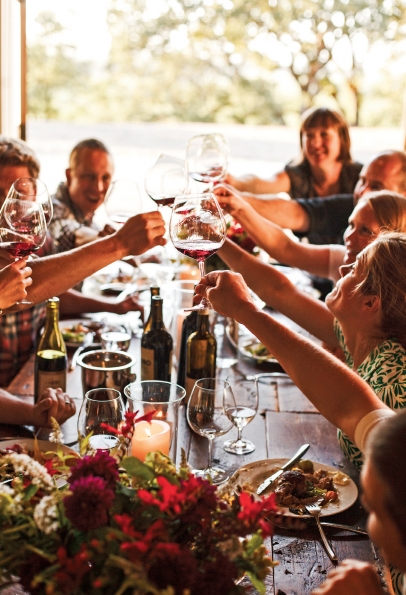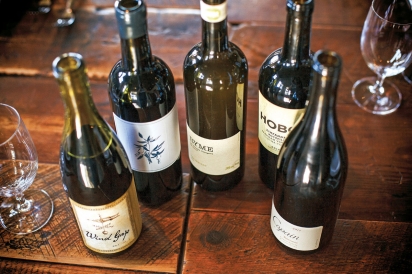Harvest 2012 in Sonoma County
Harvest is always a special time in Wine Country. Vineyards are abuzz with workers filling bins with freshly harvested fruit, trucks loaded with grapes roll down the roads on their way to crush pads and winery facilities are firing on all cylinders.
The harvest in Sonoma County begins sometime in mid to late August for thinner-skinned grapes such as Chardonnay and Pinot Noir, and may not conclude until mid November for the later-ripening varieties such as Cabernet Sauvignon.
For the dedicated folks at every level involved in making wine, sleep is at a premium for weeks on end. And not just because fruit is now often picked at night, with the vine- yards lit like a movie set. (Picking grapes at night helps protect the pickers from intense daytime heat, keeps the grapes cool for the crush and lessens traffic on the roads.) It’s nonstop for eight to 10 weeks or more, depending on which grape varieties are being harvested.
Somehow we were able to lasso some of our favorite Sonoma County winemakers in advance of the crush and ask them a few questions. We asked each to tell us about the "aha!” moment that brought them to the wine business, their greatest challenges during harvest, how they decide when to pick, how long their harvest usually lasts and which varieties of wine they find the easiest to make—and the most difficult.
Wells Guthrie
Winemaker at Healdsburg’s Copain Wines
While I was working as a tasting coordinator at the Wine Spectator, Tom Garrett, one of my co-workers, invited me to his family’s home and vineyard in Oakville. At dinner that night his grandmother stood up and told the story of how his grandfather bought the property and planted the vines. She then commented that the wine we were having that night was from the property and that everyone there— outside of myself, of course—helped make that wine. There were three generations plus of family there that night and the stories that followed about how they picked and made the wine, and the bond they shared over it, gave me chills. That night I told my wife about my experience and how I wanted to be able to have that type of experience for my own family. Six months later, after 40 letters to producers in the Rhone Valley [in France], I was working for Chapoutier, one of the truly great producers in the Northern Rhone.
There are always new challenges with each vintage—weather issues, presses breaking—so it’s hard to pick just one as a consistent one. I guess I’d say just that the ultimate challenge is making a decision to pick and getting the fruit off the vine. Watching weather patterns, sampling, getting a crew lined up to pick and getting the fruit off early. I don’t pick as ripe now so I find it has become easier to get crews these days as I am picking before most in Anderson Valley for Pinot, but the weather the past two years and the fires of ’08 were insane.
I find my idea of "ripe” has changed. I tend to like the brighter acids and fruit profiles. Outside of flavors, I tend to pick now when the fruit just starts to soften ever so little. The berries are still pretty turgid when they come in, but have just started to turn.
Harvest starts at the end of August as we get fruit from Chalone [near Soledad] that tends to come in the last week of the month. Syrah can go until end of October at times, given the year and our cooler sites. In the last couple of years in Anderson Valley and Yorkville Highlands, Syrah is coming in in late October.
Pinot is by far the hardest. It’s thin skinned and doesn’t like heat spikes, rain, etc. Syrah is easiest. It’s thick skinned and tends to handle the weather much better. Plus, in the cellar there are no punch-downs—just a quick five-minute pump- over every day.
Duncan Arnot Meyers and Nathan Lee Roberts
Winemakers at Healdsburg’s Arnot-Roberts
We made our first barrel of wine in our backyard in Healdsburg in 2001. It was a Dry Creek Valley, dry-farmed old-vine Zinfandel.
With 20 different sites, the biggest challenge for us is distance. During harvest we spend a lot of time on the road getting around to all of our vineyards from Santa Cruz to Mendocino.
Picking decisions differ for each site and variety. Of course, everyone wants to say that they pick when the grapes are at optimum maturity and we are no different, although we may have a more conservative view of what constitutes optimum maturity.
Harvest usually begins the first or second week in September and lasts until mid November. Our Syrahs come from cool sites that are usually picked on the eve of the season-ending storm in Northern California, which is usually early to mid November. Our latest pick in 2011 was November 18 for our Clary Ranch Syrah grown in the Petaluma Gap.
The easiest variety to work with seems to be Cabernet, with its sturdy tannins and pigment. The most finicky is Trousseau, with its thin skins and oxidative nature. The most difficult wine to make is our rosé of Touriga Nacional. Our rosé is destined for early release in February of the following year, so making this wine requires multiple critical decisions and steps to achieve a fresh and balanced wine.
Ryan and Megan Glaab
Winemakers at Sonoma County’s Ryme Cellars and Verse Wines
Ryan: I didn’t really grow up in a wine or food family, but was always fascinated by new smells and flavors. I got into beer first, and then wine, in high school and college. At some point it occurred to me that one could make wine for a living and I knew it was for me. I am also the assistant wine- maker at Pax and Pam Mahle’s Windgap Winery.
Megan: I grew up in the restaurant industry. I cultivated an appreciation for wine at an early age working at my family’s restaurant, Passionfish, in Pacific Grove, then studied enology in Australia after high school.
We started Ryme five years ago, with a focus on producing wines from more esoteric [grape] varieties and fermentation methods. We produce Aglianico, Ribolla Gialla, Vermentino and Cabernet Franc. Verse is the companion portfolio of wines that may be less of a surprise to the drinker. This is our first year producing Pinot Noir and Chardonnay that is very clean, bright and swillable.
The greatest challenge is time management and staying ahead of every wine. Harvest is a challenging time of very long days with lots of important decisions, and also the need to maintain a connection to family life. It is also an extremely exciting time that we all look forward to. You become intimate with a new set of wines. Every year provides a surprise set of twists and new circumstances. And every year we learn a great deal from our peers and their experiences, as well as their generous sharing of wines.
The needs of every vineyard and every wine are different. We need to weigh the flavors of the grapes with a range of potential alcohol, pH and acids. We pick usually between September 15 and October 31, starting with Pinot and ending with either Aglianico or Cab Franc.
The most difficult grape varietal? Aglianico. We get dismal yields in the vineyard. [They are] extremely low-vigor vines, with frequent shatter problems. It is also a very late ripener. In the winery it has brutish tannins and super-high acidity that doesn’t cooperate with our native MLF [malolactic fermentation]. It takes years in the barrel and is made to drink years from now. It is totally engaging and idiosyncratic. It
is the most challenging and also the most exciting for us. The easiest? Vermentino. It sets a huge crop. It is delicious and incredibly aromatic from the start—bottled and out the door for spring drinking. Or maybe Pinot; I don’t know why everybody whines about it being finicky.
Pax Mahle
Winemaker at Forestville’s Wind Gap Wines, Pax Wine Cellars, Agharta Wines and Lucques
My "aha!” moment? Walking vineyards in France with great old winemakers that knew the land, respected the soil, appreciated wine as a component of their life and their meals, not as a status symbol or lifestyle, but a way of life... These guys had a connection with wine that went beyond anything I had seen before and I wanted that connection. I wanted to have that feeling.
Greatest challenge during harvest? Staying sober.
Picking is based on that magical moment when the vines look exhausted and are clearly unable to improve what is already in the grapes, the flavors are ripe yet vibrant and the chemistry is correct to make a stable wine without the addition of water, acid or sugar... tools that are often abused unnecessarily by far too many winemakers.
For Wind Gap, we typically harvest our Pinot Gris and Trousseau Gris the first week of September and our last Syrah typically mid November—so harvest is a very long event for me.
Grenache is tough and requires a lot of my time and energy, much like Pinot Noir does, but the "most difficult” award goes to Nebbiolo. The acids are incredibly high in this grape and it isn’t uncommon to have to delay harvest until the acids soften and the tannins ripen and hopefully both of these things can happen before the sugars skyrocket.
Kenny Likitprakong
Winemaker for his own labels including The Hobo Wine Company, Folk Machine, Ghostwriter, The Make-Work Wine Company and Banyan Wines, as well as for other small wine labels including Urbanite Cellars and Compass Rose Wines
An "aha!” moment? I can’t say it was like that. I started drink- ing more wine when I was about 19 or 20 and living and working in San Francisco. I was working with this wine marketing company where there was a lot of French wine around, and things started to click. I grew up at a winery in Sonoma County, so knew what the work was about. I’m kind of project-oriented and have trouble sitting still, so it all started to seem like a good idea. The more I do it, the more I like it.
Greatest challenge during harvest? Staying sane. Spending time with my family. Being everywhere at the same time. Cell phone batteries. Rain.
A lot of times we decide when to harvest based on the way the vines look or what weather is ahead. In the best situations, we can rely on flavor, sugar, pH and TA [titratable acidity] levels.
We generally harvest from late August through Thanksgiving. We will harvest grapes for nine to 10 weeks, but what we consider "harvest” will go another two to three weeks after the final picking.
There are no easy varietals, but some are easier in some vintages. Chardonnay is always difficult for us. Zinfandel is usually a challenge. Whites other than Chardonnay tend to be easier.






